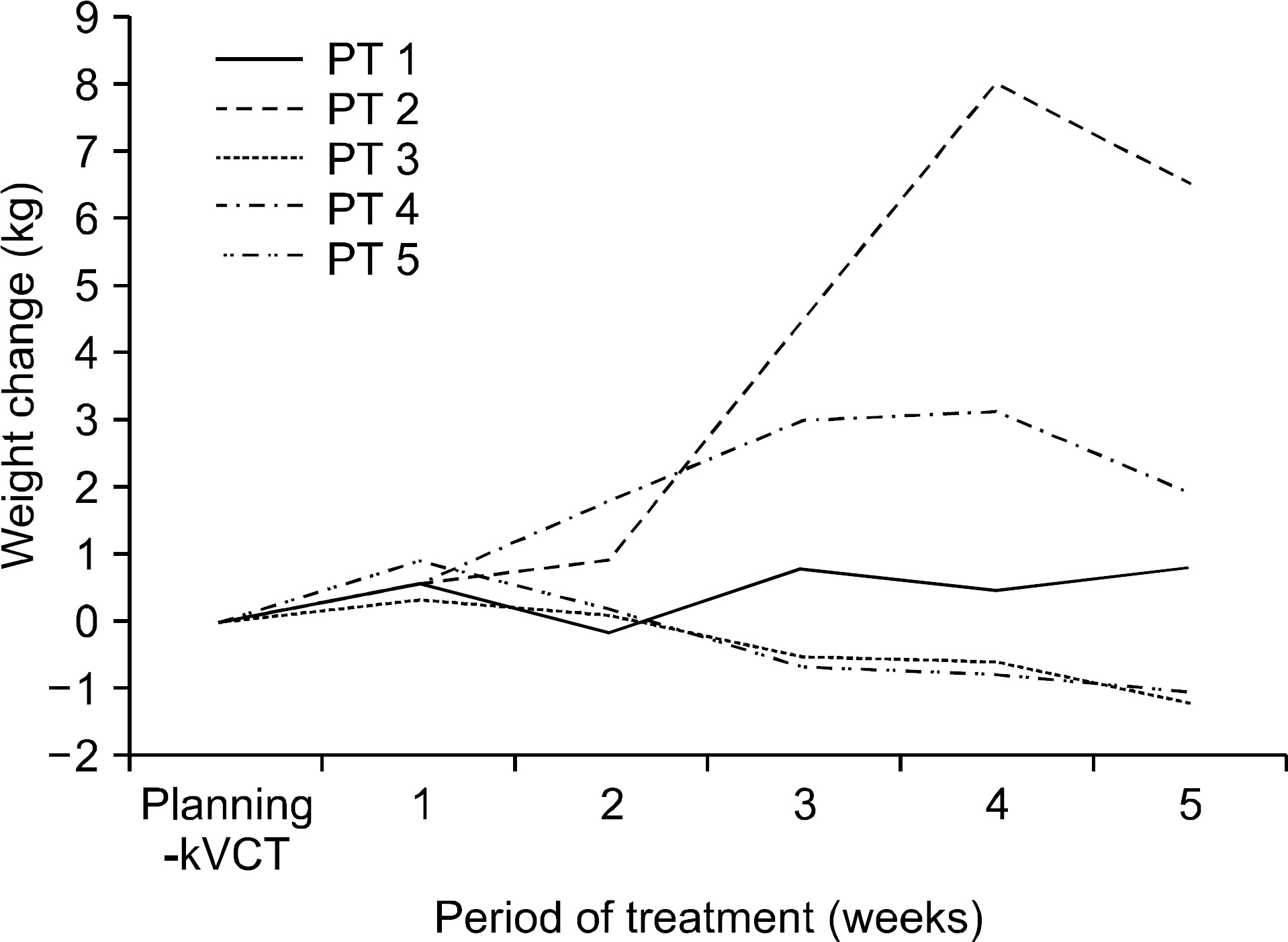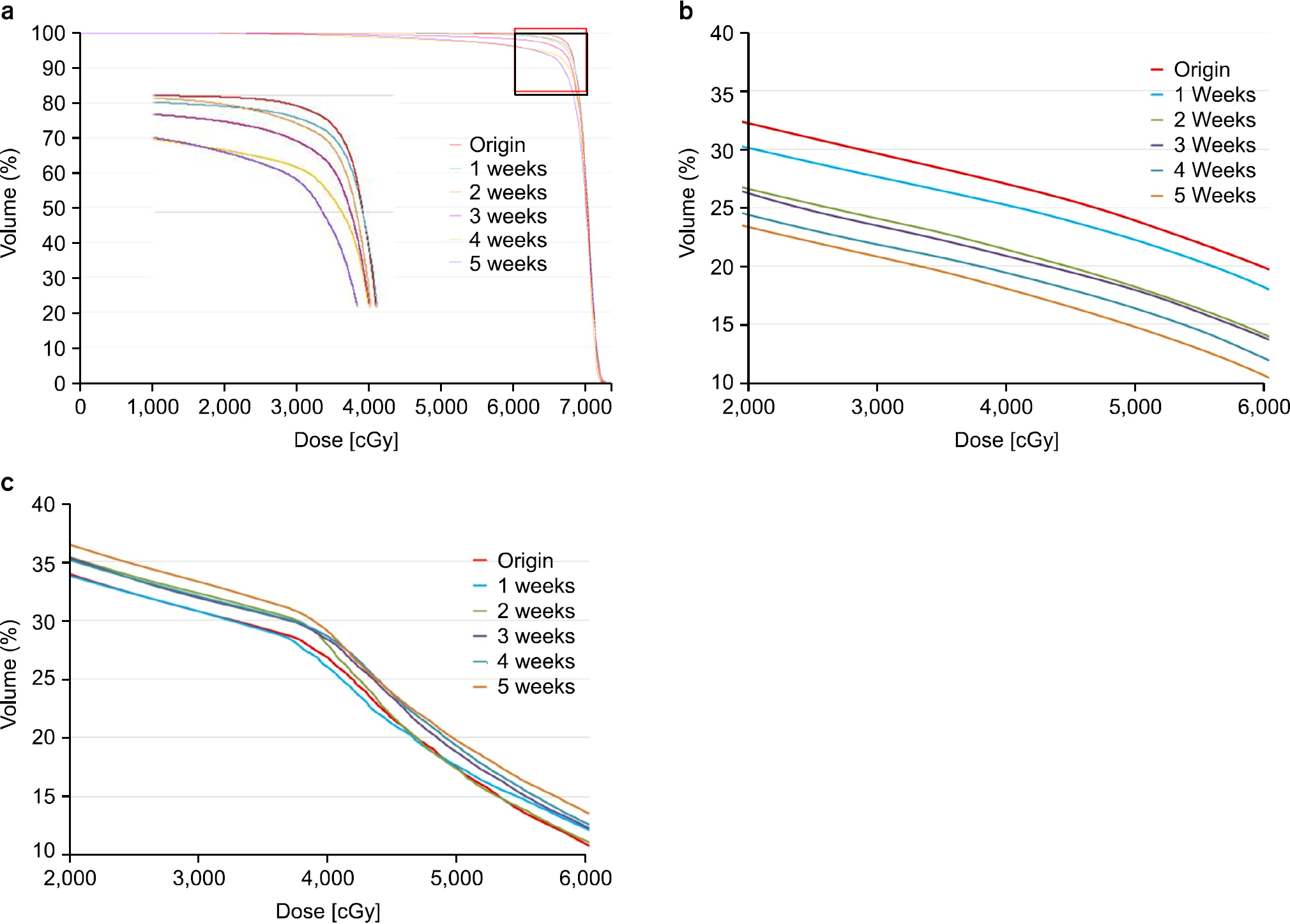Prog Med Phys.
2014 Sep;25(3):167-175. 10.14316/pmp.2014.25.3.167.
Evaluation of Dose Change by Using the Deformable Image Registration (DIR) on the Intensity Modulated Radiation Therapy (IMRT) with Glottis Cancer
- Affiliations
-
- 1Department of Radiation Oncology, Soonchunhyang University College of Medicine, Cheonan, Korea.
- 2Department of Medical Physics, Kyonggi University, Suwon, Korea. gdlee@kyonggi.ac.kr
- 3Department of Radiation Oncology, College of Medicine, Korea University, Seoul, Korea.
- 4Research Center for Radiotherapy, Korea Institute of Radiological and Medical Science, Seoul, Korea.
- 5Department of Biomedical Engineering and Research Institute of Biomedical Engineering, The Catholic University, Seoul, Korea.
- 6Department of Electrophysics, Kyonggi University, Suwon, Korea.
- KMID: 1910549
- DOI: http://doi.org/10.14316/pmp.2014.25.3.167
Abstract
- The purpose of this study is to evaluate the variation of the dose which is delivered to the patients with glottis cancer under IMRT (intensity modulated radiation therapy) by using the 3D registration with CBCT (cone beam CT) images and the DIR (deformable image registration) techniques. The CBCT images which were obtained at a one-week interval were reconstructed by using B-spline algorithm in DIR system, and doses were recalculated based on the newly obtained CBCT images. The dose distributions to the tumor and the critical organs were compared with reference. For the change of volume depending on weight at 3 to 5 weeks, there was increased of 1.38??.04 kg on average. For the body surface depending on weight, there was decreased of 2.1 mm. The dose with transmitted to the carotid since three weeks was increased compared be more than 8.76% planned, and the thyroid gland was decreased to 26.4%. For the physical evaluation factors of the tumor, PITV, TCI, rDHI, mDHI, and CN were decreased to 4.32%, 5.78%, 44.54%, 12.32%, and 7.11%, respectively. Moreover, Dmax, Dmean, V67.50, and D95 for PTV were increased or decreased to 2.99%, 1.52%, 5.78%, and 11.94%, respectively. Although there was no change of volume depending on weight, the change of body types occurred, and IMRT with the narrow composure margin sensitively responded to such a changing. For the glottis IMRT, the patient's weight changes should be observed and recorded to evaluate the actual dose distribution by using the DIR techniques, and more the adaptive treatment planning during the treatment course is needed to deliver the accurate dose to the patients.
MeSH Terms
Figure
Reference
-
References
1. Rosenthal DI, Fuller CD, Barker JL Jr, Mason B, Garcia JA, Lewin JS. Simple carotid-sparing intensitymodulated radiotherapy technique and preliminary experience for T1–2 glottic cancer. Int J Radiat Oncol Biol Phys. 77(2):455–461. 2010.
Article2. Geets X, Tomsej M, Lee JA, et al. Adaptive biological imageguided IMRT with anatomic and functional imaging in pharyngolaryngeal tumors: Impact on target volume delineation and dose distribution using helical tomotherapy. Radiother Oncol. 85:105–115. 2007.
Article3. Wu Q, Chi Y, Chen PY, et al. Adaptive replanning strategies accounting for shrinkage in head and neck IMRT. Int J Radiat Oncol Biol Phys. 75:924–932. 2009.
Article4. Hunter KU, Fernandes LL, Vineberg KA, et al. Parotid glands dose-effect relationships based on their actually delivered doses: implications for adaptive replanning in radiation therapy of head-and-neck cancer. Int J Radiat Oncol Biol Phys. 87(4):676–682. 2013.
Article5. Nishimura Y, Nakamatsu K, Shibata T, et al. Importance of the initial volume of parotid glands in xerostomia for patients with head and neck cancers treated with IMRT. Jpn J Clin Oncol. 35:375–379. 2005.
Article6. Schwartz DL, Garden AS, Thomas J, et al. Adaptive radiotherapy for head-and-neck cancer: Initial clinical outcomes from a prospective trial, Int. J. Radiat. Oncol. Biol. Phys. 83:986–993. 2011.7. Mencarelli A, van Beek S, van Kranen S, Rasch C, van Herk M, Sonke JJ. Validation of deformable registration inhead and neck cancer using analysis of variance. Med Phys. 39(11):6879–6884. 2012.8. Yan D, Liang J. Expected treatment dose construction and adaptive inverse planning optimization: implementation for offline head and neck cancer adaptive radiotherapy. Med Phys. 40(2):021719. 2013.
Article9. Mike O, Jeff C, Eugene W, Jake VD, Francisco P. A treatment planning study comparing whole breast radiation therapy against conformal, IMRT and tomotherapy for accelerated partial breast Irradiation. Radiother Oncol. 82:317–323. 2007.10. Bhide SA, Davies M, Burke K, et al. Weekly volume and dosimetric changes during chemoradiotherapy with intensitymoudulated radiation therapy for head and neck cancer: a prospective observational study. Int. J. Radiat. Oncol. Biol. Phys. 76:1360–1368. 2010.11. Barker JL, Gargen AS, Ang KK, et al. Quantification of volumetric and geometric changes occurring during fractionated radiotherapy for head-and-neck cancer using an integrated CT/linear accelerator system, Int. J. Radiat. Oncol. Biol. Phys. 59:960–970. 2004.12. Schwartz DL, Garden AS, Thomas J, et al. Adaptive radiotherapy for head-and-neck cancer: Initial clinical outcomes from a prospective trial, Int. J. Radiat. Oncol. Biol. Phys. 83:986–993. 2011.13. Lu W, Chen ML, Olivera GH, et al. Fast free-form deformable registration via calculus of variation. Phys. Med. Biol. 49:3067–3087. 2004.14. Lu W, Olivera GH, Chen Q, et al. Deformable registration of the planning image(KVCT) and the daily images(MVCT) for adaptive radiation therapy. Phys. Med. biol. 51:4357–4374. 2006.15. Ahn PH, Chen CC, Ahn AI, et al. Adaptive planning intensitymodulated radiation therapy for head and neck cancers: single-institution experience and clinical implications. Int. J. Radiat. Oncol. Biol. Phys. 3:677–685. 2011.16. Feigenberg SJ, Lango M, Nicolaou N, Ridge JA. Intensitymodulated radiotherapy for early larynx cancer: is there a role? Int J Radiat Oncol Biol Phys 1. 68(1):2–3. 2007.
Article17. Martin JD, Buckley AR, Graeb D, Walman B, Salvian A, Hay JH. Carotid artery stenosis in asymptomatic patients who have received unilateral head-and-neck irradiation. Int J Radiat Oncol Biol Phys. 63:1197–1205. 2005.
Article18. Akgun Z, Atasoy BM, Ozen Z, et al. V30 as a predictor for radiation-induced hypothyroidism: a dosimetric analysis in patients who received radiotherapy to the neck. Radiation Oncology 9:. 104:1–5. 2014.
Article19. Cheng SW, Ting AC, Ho P, Wu LL. Accelerated progression of carotid stenosis in patients with previous external neck irradiation. J Vasc Surg. 39:409–415. 2004.
Article20. Kim MY, Yu TS, Wu HG. Dose-volumetric Parameters for Predicting Hypothyroidism after Radiotherapy for Head and Neck Cancer. Jpn J Clin Oncol. 44:331–337. 2014.
Article21. Nishi T, Nishimura Y, Shibata T, Tamura M, Nishigaito N, Okumura M. Volume and dosimetric changes and initial clinical experience of a two-step adaptive intensity modulated radiation therapy (IMRT) scheme for head and neck cancer. Radiother Oncol. 106(1):85–89. 2013.
Article
- Full Text Links
- Actions
-
Cited
- CITED
-
- Close
- Share
- Similar articles
-
- Deformable image registration in radiation therapy
- Re-Irradiation of Hepatocellular Carcinoma: Clinical Applicability of Deformable Image Registration
- Enhancement of the Deformable Image Registration Accuracy Using Image Modification of MV CBCT
- Introduction of intensity modulated radiation therapy
- Intensity-modulated radiation therapy: a review with a physics perspective




